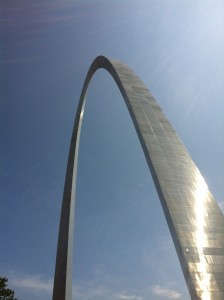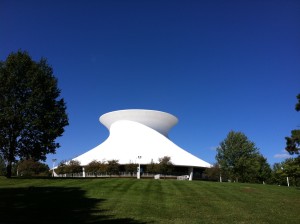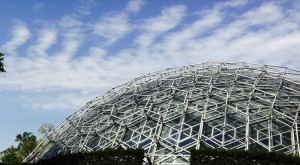Happy Birthday, Gateway Arch!
This week marks the 50th anniversary of the completion of the Gateway Arch in St. Louis, MO.
It’s official name is The Jefferson National Expansion Memorial, a U. S. National Park, which includes the Old Courthouse (1839), site of the famous Dred Scott cases (1847 and 1850). Architect Eero Saarinen won the 1948 competition for the memorial’s design. A giant parabola, the Arch is the United State’s tallest national monument.
For me, the Gateway Arch is an artistic tour de force. Conceived in the 1930’s, the memorial’s design was chosen in 1948 and came to fruition in 1965.
The Arch memorializes Thomas Jefferson’s Louisiana Purchase and the Lewis and Clark’s expedition that set in motion Westward expansion.
Space Age Elegance
The Arch also suggested skyward expansion, as it soared high above America in the midst of the space program. The Mercury and Gemini capsules were built in St. Louis at McDonnell Douglas. The McDonnell Planetarium (1962), and Missouri Botanical Garden Climatron (1960) reflected the same modern, graceful, futuristic style. The Planetarium’s design (top photo) is a hyperbole (in silhouette); the Climatron is an elegant geodesic dome.
My first professional gig as an artist was at the McDonnell Planetarium. I was 18 and hired as their artist through a college work study program. Though I was a Fine Art student, this opportunity introduced me to the world of commercial illustration and I found that was my true niche. I painted moonscapes, planets, spacecraft, and various astronomical subjects for multi-media planetarium “star shows”. It was quite a lot of fun.
Much of the fun came from roaming the beautiful building. A spiral ramp wound the exterior of the interior theater dome leading to rooftop telescopes. And yes, more than once I climbed a ladder and sat on the uppermost rim on top of the building’s exterior shell. A great view of Forest Park and the Central West End. The lower level offices, when I worked there, were round. They rode the circumference and the office walls retained the curve. Pretty cool workspace. It’s all been remodeled now, and is much better, but it had a quirky charm back then. It’s exterior is still striking, especially at night when it’s gorgeous silhouette is brightly lit. Likewise against a deep blue Summer sky, as shown above.
Back to the Arch and its 50th birthday. If you’ve never been to St. Louis you might want to postpone a visit until 2017, when the park, museum, and riverfront promenade renovations are complete. A depressed section of Interstate 70 had divided the Arch grounds from Downtown, making it accessible by a couple of unattractive crosswalks over the incessant traffic below.
We’ve now put a lid over the highway, turning it into a tunnel, and are covering that lid with a beautiful park, tying together the Old Courthouse grounds with the rest of the National Park. That will make for a pleasant walk from the park, its Arch, to the historic courthouse and on over to Busch Stadium, Ballpark Village, and the rest of downtown, where you can visit the Central Library (1912) I wrote about a couple weeks ago.
It sounds like I’ve been hired by the Chamber of Commerce. Nah, just pointing out some of our great sites, and feeling pretty good about the Arch hitting fifty. It doesn’t age, except for some weathered stains, and looks as cool and sleek as it did when it was first topped out on October 28, 1965.
Happy Birthday, Gateway Arch!
All photos ©2015 Ed Koehler





I recall the original McDonnell planetarium and the elegant design of the building. Once there was either a Mercury or Apollo space capsule on display there and various other things, such as the twin scales that would tell you your earth and moon weight. the original projection dome was 60 feet in diameter and had the Goto L1 projector, which was a bit novel for its time as it was ‘sleeker’ looking than the typical “dumbell’ design pioneered by Zeiss (so that its overall silhouette was sleeker). I recall seeing the single-color (red) laser shows which would sometimes precede the star shows.
I would disagree a bit about how the new facility is better. Yes, the newer Zeiss Universarium projector is more capable and the larger dome (now 70 feet in diameter?) is also better. But the lower entrance of the rehab basically bypasses the planetarium so that people don’t see the projection room. Indeed, last time I was there (in 2014) a visitor remarked that “there used to be a planetarium here”. No kidding.
While i like the fact that the projector is left on after the shows, it is a pity that the whole experience is more casual. For example, the dome is never kept as dark as it used to, owing to the conscious decision to keep a rather ‘open flow” feel to things. Also, when i was there, the operator seemed bored and in a hurry to get the “live” part of the show (‘tonight’s night skies’) over with. He even said something like ‘and enough of this and let’s get on with the real show…” Totally missing the opportunity for the operator to better interact with the patrons (something, i think, that the patrons would LOVE).
So some things better, some things not. At a time when very few people ever see night skies any more, i wish the planetarium would ‘amp up’ the importance of their facility, rather than going with the herd instinct and feeling that it just is no big deal anymore.
Also, the interactive displays that are off to one side of the planetarium were in really bad shape, with several exhibits out of order. Nothing turns people off to museum experience to (1) have no live attendants there to help them understand and (2) a bunch of broken exhibits. nothing says “i don’t care” more than these trends in science museums. Please, St. Louis, revitalize your approach to space science! people will gravitate toward it better
I would like to follow up to note that St. Louis (and McDonnell spacecraft) played a HUGE roll in the Mercury and Gemini space missions, to say nothing of Charles Lindbergh… back when Lambert Field was literally… a field!. Generations have gone by… and revitalizing the community’s (and the wider swath of tourists) would be great and a very unique way of addressing STEM needs. St. Louis has “space authenticity”, something not all cities (some much larger) can boast.
Thanks for your comments, Charles. I haven’t been to a planetarium show since the old days, so I’m sorry to hear the experience has been degraded. When we did the shows, the primary purpose was to identify stars, constellations, and planets. Special shows were a little more entertainment oriented, but astronomy was still the main reason for the show.
The spacecraft they had was a real Mercury capsule and a real Gemini capsule, and a mock up of an Apollo capsule, not a real one. I forget who flew in each capsule, and the Mercury I believe was not one of the famous seven, but I may be wrong. Of course only six of the seven Mercury astronaut crafts survived, as Gus Grissom’s sank.
Thanks again on the comment. By the way, how did you come across a post that was published over a year ago? Just wondering, but I’m glad you did. Ed
Thanks, Linda.
The Planetarium was cool, and it’s a shame they no longer have real Star Shows. I actually did the shows as well as some of the art. I worked as artist by day, under that work-study arrangement, and then as Planetarium attendant and show technician by night (and weekends). I stood in the control console, gave the introductory speech, explained the Goto L1 Planetarium Projector, and worked the dials and switches for the show. It was all completely analog and hands on. The control board was a wonderful array of dials, toggle switches, buttons, and such.
My favorite show was the annual Christmas show. It was a show that considered what the star of Bethlehem may have been. This was 40 some odd years ago, and there wasn’t a hint of irreligious smugness. It assumed the biblical account was true; that there actually was an astronomical phenomenon guiding the Magi. The show respectfully considered what that might have been. There are astronomical records of things happening in the skies around the time Jesus would have likely been born.
Gene Hanses was the Planetarium’s Educational Director, and quite a scientist. He was also a devout Catholic, had a degree in Philosophy from SLU, and saw absolutely no disconnect between science and faith, as do so many of the “new atheists” who regularly propound philosophical maxims without apparently knowing it. Gene and I would debate between Catholic and Protestant theology, but I respected him for being a man of science and faith, with no need to pit one against the other.
I’m glad you liked my brief tribute to the Arch, these cool mid-century structures and the vibe they give St. Louis. I know my brother signed one of those time capsule slips of paper, and I may have. I would have been in 5th grade. I signed whatever they told me to, so hopefully I got in :). Thanks so much for your memories Linda!
Ed, thanks for focusing on the Arch and also the Planetarium. That is wonderful that you were an artist at the Planetarium when you were so young! What talent! I have always loved that building…somewhere, I have a photo of me standing in front of it when it was being built, and you can see the unmistakable silhouette in the structural framework. I sure do miss the old Star Shows in the old theater, however.
The Arch is another mid-century design marvel. My dad’s 1949 yearbook from Wash. U. shows a model of it, which first clued me in to how early the design was done.
A little boy I know asked his mother if the Arch was God’s handle for the world. I’m certainly glad that God has a “handle on the world”!
I was one of the school children whose signatures were placed in the time capsule in the top segment (4th grade) and we could actually see the Arch going up from our classroom window. It is such a beautiful, streamlined structure and I’m proud of the way it symbolizes St. Louis!